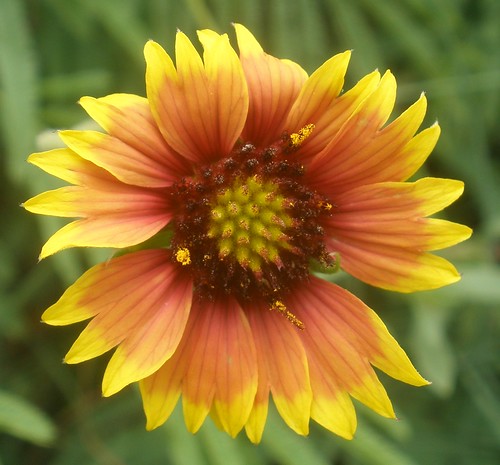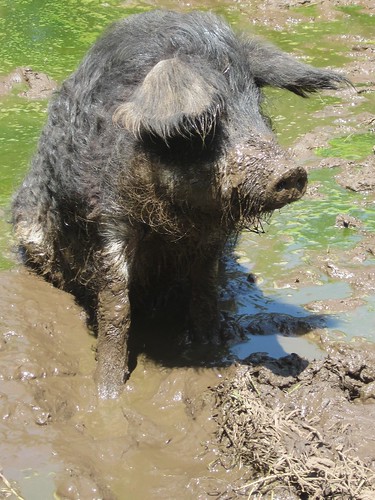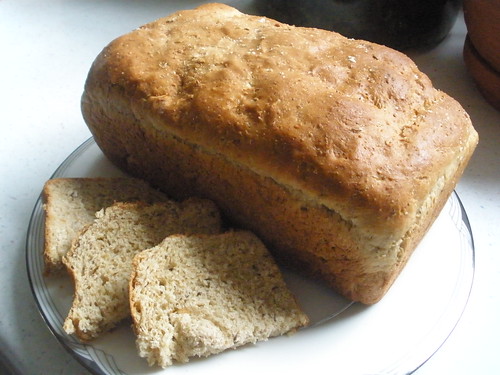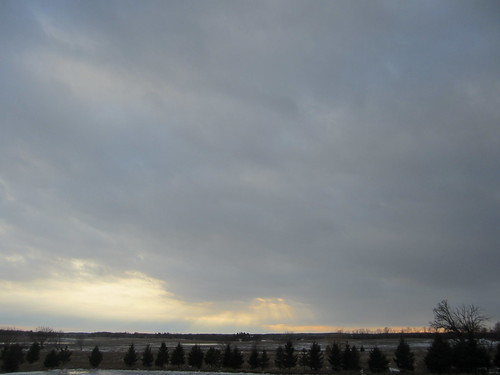In choosing this book, I had hoped for a greater percentage of it relating to food and gardening. However, each chapter - which focuses on a different person - spends more time sharing the person's life story than it does about the gardening and agricultural aspect of their lives.
Nonetheless, the stories are quite fascinating...some tragic and heart-breaking while others tell of hope and anticipation of immigrating to the United States. A common theme is summarized by one of the people featured in the book: "First you lose your costume. Then you lose your language. The last thing you lose is your food."
It is these three distinct phrases: "the shock, the intense pressure to conform, and the losses that have shaped the lives of generations of immigrants to America" that many of these immigrants' stories revolve around.
Artistry and Beauty
One of the stories in The Earth Knows My Name focused on a man who was imprisoned for a crime he didn't commit. Yet he passed the time as contentedly as he could when he imagined himself in a garden with "grassy paths and meadows beyond" He wrote of singing birds, grass leaves reflecting the sky, sun, moon, and stars; and "a ' rainbow cloud' of pollinators [that] would rise up with each step."
The book said, "Even in his extreme circumstance - he was allowed only one hour a day to walk outside - [he] relished the aesthetic and sensual satisfactions of a garden ..... To walk the garden's paths, even in memory, surrounded by clouds of insects, singing birds, and drifts of wildflowers, restores to this man stripped of his freedom - a man in exile, stateless, soon to be robbed of his very life."
A Native American farmer mentioned how they use open-pollinated, heirloom varieties of seeds that they receive from Native Seeds/SEARCH. "They provide the palette, and we, the farmers, we're the artists. We paint the land."
Another person describes wanting to live in a rural area on a farm and then creating a beautiful place to live: "I came here because I wanted to have a way to live in beauty."
An immigrant from India transformed her yard into a thriving garden that produces fruit, vegetables, and herbs. It also is designed to attract pollinators. She explains, "This part of the garden is for my bees. I'm trying to plant as many flowers as possible to invite them. The hummingbirds love this part too."
Flower on South Padre Island.
(Taken on April 30, 2010)
Gardening and Farming as an Economic Necessity
Besides providing emotional benefits, some of the people spoke of the necessity of gardening to provide food for a family. As one person said, "If you didn't have a garden, you didn't eat as well."
What was intriguing was that back in the 1950s in one farming community, a person said, "Some [people] had cows. Some had chickens, some had pigs. Not everybody had all of those things. But it was a farming community, so you didn't need to - you could barter for whatever you needed."
A pig at a local Community Supported Agriculture farm.
(Taken on June 2, 2012.)
I like that idea of bartering and sharing what you have for what you need. Not only does it build a sense of community, it helps people afford to live - especially if they are struggling financially.
Another farmer who was giving a tour of his garden had "reached the end of the path. On this end of the garden shed, [he] had placed an old sink under the downspout 'to collect the rain.' Nothing is wasted here - not light, not soil, not rain, food, time, or work."
This is a great philosophy to have, and one that I need to more carefully consider. For the past two summers, we have had drought-like conditions. Conserving whatever water is available (especially from rain) is something that makes a lot of sense, especially when we are dependent on well water.
Passing Down Traditions
A gardener, when asked what was going through his mind when he planted his garden said, "I'm paying homage to my parents, very consciously, in the garden. You know, our parents die, but they're always with us."
I couldn't agree more. When I look at a particular tree that was planted here at the farm by my Dad and brother; and perennials that my Dad shared with me, it reminds me of him. My parents had blue flax that used to grow in my grandma's garden. My mom always felt a special connection to her through the beautiful flowers each summer.
An African-American farmer said, "The seeds of the original African American gardens - okra, yams, peanuts, watermelons, pigeon peas, and other African foods that [I] still grow - came with the slave trade and were cultivated in the slaves' small allotment gardens - 'provision gardens,' as they are known."
These gardens were essential to slave owners because of the "economic burden of providing for the slaves .... [They also] discouraged runaways, because, as masters noted, slaves tended to become deeply attached to their gardens and their animals."
Regarding seed saving, "Sixty years ago it was common to save seeds; they were a part of every harvest. Now people buy books to learn how- and why - it is crucial to preserve them."
Bean seeds starting to sprout.
(Taken on March 4, 2011)
Seed saving isn't something I've done before, but it would be a good skill to learn this summer. It would be nice to be able to pass down seeds to Sophia and Olivia for them to use in their own gardens when they are on their own as adults.
Food as Being Central to Culture
Another person talked about how food in Europe is central to their culture. "They eat in big groups, multi-generational groups....That's how food should be - it should be part of your relationships with people, especially your family."
In one of the chapters, there is a delightful image of an outdoor meal: "There are great wooden bowls of green salad and ceramic bowls filled with red, white, gold, blue, and purple roasted potatoes. There is fresh bread - baguettes, rounds, and loaves - and white goat cheese, bowls of beans and plates of sliced tomatoes, a platter mounded with steaming corn. There are berry pies, bowls of fresh berries, cakes, and cookies."
Caraway rye bread that we made.
(May 11, 2010)
The description continued, "Nearby, tables and chairs are set out on the grass around a beehive oven shaped like a great frog with its mouth open wide. [There is a] wood fire and [two women] are making fresh pizza with tomatoes and basil grown in the field."
I always longingly look at beautifully-decorated outdoor tables filled with food fresh from the garden. Perhaps that is something that I should aim to do when there isn't snow on the ground.
Pressure to Develop
One of the signs at an organic farm on the west coast summed up what many farmers are experiencing throughout the country. Even here in Minnesota in our small, rural community, this is an issue:
"Pressures to develop farmland like this are great. New farmers can't afford to buy land at development prices to grow vegetables, yet older farmers have no retirement income other than their land, and they can't afford to sell it at a price the young farmers can pay. So how can we, as members of a community, keep farms like this alive, providing us with food for both body and soul?"
View from our neighbor's balcony looking west
towards the back part of our farm.
The pine trees mark the east side of our property.
About 350 feet beyond that to the west starts the neighbor's farm.
(Taken on March 8, 2012)
Gardening and a Sense of Community
Something that was mentioned that made me pause to reflect was the statement: "We use the phrase, 'We are what we eat,' but I also think we are where we eat. That's the thing that people miss. This need to be of a place, to be of a community."
One farmer said, "My dream is...to save the beauty in world by getting people to eat from where they live."
There was a town in Italy that was described that I thought captured the spirit of community: "The women spin the yarn and do their own weaving. They made all their own clothes. They made their own shoes. Very fancy shoes. There was nothing we didn't make. Remember, the town had no money. So you basically did everything yourself. There was a communal bakery, a communal mill. And you brought the grain to the mill, and they would grind it for you and you'd bring it home in a sack, the flour."
Inside the windmill at Pella, Iowa.
They still grind wheat into flour.
(Taken on April 29, 2009)
He continued, "When you made your bread, if you didn't have a baking oven, a masonry one, outside or inside your house, you'd bring it to a communal bakery. There was one in town. That's where women used to go and bake bread and visit and talk."
Back at the farms in Italy, "At lunchtime, someone would come out with food - bread and cheese - and they'd all sit down."
Currently, I'm a board member of the local farmers market. Trying to create a sense of community is a goal of mine. Besides purchasing food at the market, there has to be some sort of draw - some connection that people can make with one another. Having a wood-fired oven for bread baking and pizza making would be a great start to making this happen.
Summary
The Earth Knows My Name was different than I expected, yet it was interesting to read the stories of different immigrants and how - when the human community had failed them - the community of the land did not. The garden "is where they affirm a sense of who they are and where they come from."
There are many inspiring ideas about how to create that sense of connection - with the land and with one another - from the stories shared in this book. I'm hoping that this summer will be the start to trying to implement some of these ideas - both at our farm and with the local farmers market with which I am involved.








No comments:
Post a Comment